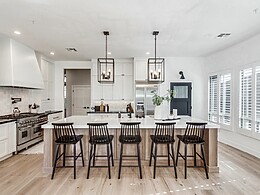Written by Joey Hancok

Installing porcelain countertops in kitchens is the next big thing in home design. First starting as a trend in Europe the use of porcelain in kitchens has begun to catch on in the United States, first starting in California and now moving into Arizona. The durability, ease of cleaning, and sleek design is drawing people to this new kitchen surface.
Working with a fabricator and following a few simple steps a homeowner can install a new porcelain countertop. When installing porcelain countertops proper precautions also need to be taken into consideration in order not to damage the porcelain slab.
What you need:
- Porcelain slab cut to size
- Plywood
- Epoxy or Mortar, Trowel
- Caulking, Caulking Gun
- Cart (for carrying the porcelain)
- Electric Grinder
- Resin
- Microfiber Cloth
Material Sizes

Before installing the countertop you will need to measure your surface area. Take your measurements to a fabricator and have them cut the porcelain to match your dimensions.
Porcelain used in countertops is the same material found in porcelain tile floors. Large slabs of porcelain come in sizes up to 10X5 and it is much lighter than other materials, such as granite and quartz.
The thinness of porcelain provides for easy installation. Due to the thinness of porcelain, you can install the surface over the top of existing countertops with minimal work. This thinness can also cause cracks if you are not careful during the installation process.
Pre-Installation Process
Applying an underlayment to the cabinet before installing is necessary in order to get the proper height. Since porcelain is a thinner material, placing plywood on the countertops first is essential.
Once the plywood is in place, cover the area entirely with mortar or epoxy.
Installing the Porcelain
Carefully move the porcelain on carts to the countertop and set in place. Ensure the porcelain is level on the underlayment and press down gently. Allow the porcelain to set properly in the mortar creating a tight seal.
Once the porcelain is set use caulking to seal the edges of the surface to the backsplash and other areas where there may be small gaps. When the porcelain is in place any smoothing of edges or corners with a grinder can take place.
Challenges in Installation
When working with porcelain, most challenges arise in the fabrication process.Fabricators cutting the porcelain slabs with improper equipment causes cracks and chips in the surface.
Carrying the porcelain slabs is not recommended. Instead, transfer the slabs from the fabrication area to the kitchen for installation. During the installation process you must be careful when setting the porcelain in place. Cracking of the porcelain can occur if the underlayment on the countertop is not even. Once the porcelain is cracked a new slab will need to be cut.
Done properly, the installation of a porcelain countertop in your kitchen will last for years to come due to its durability. Porcelain is UV resistant allowing the installation of porcelain in front of large windows receiving a lot of sunlight without fading. Porcelain is also heat resistant allowing a person to set a hot pot on the surface without the worry of cracking. Induction burners are also being implemented into the porcelain surface where a person can cook directly on the countertop surface.
Regular cleaning and maintenance of the porcelain will provide the home with a countertop that will continue looking new. If any cracks or chips do appear on the surface contact your local countertop specialist for repairs.
Finishing Touches
When the installation is complete wipe down the surface with a microfiber cloth and checks for any chips or cracks. A resin filler can be used to fill in any small blemishes on the surface.










